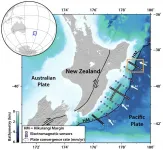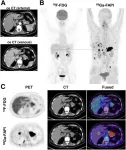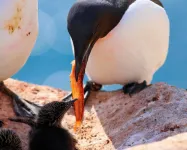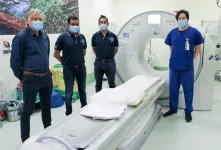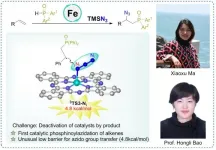(Press-News.org) Scientists from Trinity College Dublin are homing in on a recipe that would enable the future production of entirely renewable, clean energy from which water would be the only waste product.
Using their expertise in chemistry, theoretical physics and artificial intelligence, the team is now fine-tuning the recipe with the genuine belief that the seemingly impossible will one day be reality.
Initial work in this area, reported just under two years ago, yielded promise. That promise has now been amplified significantly in the exciting work just published in leading journal, Cell Reports Physical Science.
Energy for a song - the theory, and the problem
Reducing humanity's carbon dioxide (CO2) emissions is arguably the greatest challenge facing 21stcentury civilisation - especially given the increasing global population and the heightened energy demands that come with it.
One beacon of hope is the idea that we could use renewable electricity to split water (H2O) to produce green, energy-rich hydrogen (H2), which could then be stored and used in fuel cells. This is an especially interesting prospect in a situation where wind and solar energy sources produce electricity to split water, as this would allow us to store energy for use when those renewable sources are not available.
The essential problem, however, is that water is very stable and requires a great deal of energy to break up; there is no point using much more energy than you get back from such an effort. A particularly major hurdle to clear is this "overpotential" associated with the production of oxygen, which is the bottleneck reaction in splitting water to produce H2.
Although certain elements are effective at splitting water, such as Ruthenium or Iridium, these are prohibitively expensive and scarce for global commercialisation. Other, cheaper options tend to suffer in terms of their efficiency and/or their robustness. In fact, at present, nobody has discovered catalysts that are cost-effective and robust for significant periods of time.
So, how do you solve such a riddle? Stop before you imagine lab coats, glasses, beakers and funny smells; this work was done entirely through a computer.
By bringing together chemists and theoretical physicists, the Trinity team behind the latest breakthrough combined chemistry smarts with very powerful computers to find one of the "holy grails" of catalysis.
What did the team find?
Then: Two years ago, the team discovered that science had been underestimating the activity of some of the more reactive catalysts and, as a result, the dreaded "overpotential" hurdle seemed easier to clear. Furthermore, in refining a long-accepted theoretical model used to predict the efficiency of water splitting catalysts, they made it far easier to search for the elusive "green bullet" catalyst.
Now: Their subsequent searches, made using an automated combinatorial approach and advanced quantum chemical modelling, have pinpointed nine earth-abundant combinations of metals and ligands (which glue them together to generate the catalysts) as highly promising leads for experimental investigation.
Three metals stand out (chromium, manganese, iron) for the team as being especially promising. Thousands of catalysts based around these key components can now be placed in a melting pot and assessed for their abilities as the hunt for the magic combination continues.
Max García-Melchor, Ussher Assistant Professor in Chemistry at Trinity, is the senior author on the landmark research. He said:
"Two years ago, our work had made the hunt for the holy grail of catalysts seem a little more manageable. Now, we have taken another major leap forward by narrowing the search area significantly and speeding up the way we search.
"Until recently we were looking for a tiny needle in a huge haystack. After reducing the size of the haystack, we have now hoovered up plenty of the remaining hay. To put a sense of scale on this, two years ago we had screened 17 catalysts. Now we have screened 444 and believe it won't be long before we have a database with 80,000 'screenable' catalysts in it.
"'How can we live sustainably?' That is arguably the biggest and most pressing question facing 21st century society. I believe researchers from all disciplines can help to answer that, and we feel a particular strength of our pursuit is the multi-disciplinary approach we are taking."
Michael Craig, PhD Candidate at Trinity, is the first author of the journal article. He added:
"It seems hopeful that science could provide the world with entirely renewable energy, and this latest work provides a theoretical basis to optimise sustainable ways to store this energy and goes beyond that by pinpointing specific metals that offer the greatest promise.
"A lot of research has focused on the effective yet prohibitively expensive metals as possible candidates, even though these are far too rare to do the heavy lifting required to store enough hydrogen for society. We are focused on finding a long-term, viable option. And we hope we will."
INFORMATION:
The research has been supported by the Irish Research Council and the Irish Centre for High-End Computing (ICHEC), where the team is benefiting from 4,500,000 CPU hours at Ireland's state-of-the-art super-computer facility.
Researchers from North Carolina State University have developed a patch that plants can "wear" to monitor continuously for plant diseases or other stresses, such as crop damage or extreme heat.
"We've created a wearable sensor that monitors plant stress and disease in a noninvasive way by measuring the volatile organic compounds (VOCs) emitted by plants," says Qingshan Wei, co-corresponding author of a paper on the work. Wei is an assistant professor of chemical and biomolecular engineering at NC State.
Current methods of testing for plant stress or disease involve taking plant tissue samples and conducting an assay in a lab. However, this ...
The Hikurangi Margin, located off the east coast of the North Island of New Zealand, is where the Pacific tectonic plate dives underneath the Australian tectonic plate, in what scientists call a subduction zone. This interface of tectonic plates is partly responsible for the more than 15,000 earthquakes the region experiences each year. Most are too small to be noticed, but between 150 and 200 are large enough to be felt. Geological evidence suggests that large earthquakes happened in the southern part of the margin before human record-keeping began.
Geophysicists, geologists, and geochemists from throughout the world have been working together to understand why this plate boundary behaves as it does, producing both imperceptible silent earthquakes, but also potentially major ...
Reston, VA--For patients with pancreatic ductal adenocarcinomas (PDAC), molecular imaging can improve staging and clinical management of the disease, according to research published in the June issue of The Journal of Nuclear Medicine. In a retrospective study of PDAC patients, the addition of PET/CT imaging with 68Ga-FAPI led to restaging of disease in more than half of the patients, most notably in those with local recurrence.
PDAC is a highly lethal cancer, with a five-year survival rate of less than 10 percent. Optimal imaging of PDAC is crucial for accurate initial TNM (tumor, node, metastases) staging and selection ...
Dancing with music can halt most debilitating symptoms of Parkinson's disease
First-of-its-kind York U study shows participating in weekly dance training improves daily living and motor function for those with mild-to-moderate Parkinson's
TORONTO, July 7, 2021 - A new study published in Brain Sciences today, shows patients with mild-to-moderate Parkinson's disease (PD) can slow the progress of the disease by participating in dance training with music for one-and-a-quarter hours per week. Over the course of three years, this activity was found to reduce daily motor issues such as those related to balance and speech, ...
When a head of state or government official travels to another country to meet with his/her counterpart, the high-level visit often entails a range of public diplomacy activities, which aim to increase public support in the host country. These activities often include events such as hosting a joint press conference, attending a reception or dinner, visiting a historic site, or attending a social or sports event. A new study finds that public diplomacy accompanying a high-level visit by a national leader increases public approval in the host country. The findings are published in the American Political ...
The Arctic is warming at approximately twice the global rate. A new study led by researchers from McGill University finds that cold-adapted Arctic species, like the thick-billed murre, are especially vulnerable to heat stress caused by climate change.
"We discovered that murres have the lowest cooling efficiency ever reported in birds, which means they have an extremely poor ability to dissipate or lose heat," says lead author Emily Choy, a Postdoctoral Fellow in the Natural Resource Sciences Department at McGill University.
Following reports of the seabirds dying in their nests on sunny days, the researchers trekked the cliffs ...
Data from nine cities in Mexico confirms that identifying dengue fever “hot spots” can provide a predictive map for future outbreaks of Zika and chikungunya. All three of these viral diseases are spread by the Aedes aegypti mosquito. Lancet Planetary Health published the research, led by Gonzalo Vazquez-Prokopec, associate professor in Emory University’s Department of Environmental Sciences. The study provides a risk-stratification method to more effectively guide the control of diseases spread by Aedes aegypti. “Our results can help public health officials to do targeted, proactive interventions ...
Prostate cancer is the most diagnosed cancer and a leading cause of death by cancer in Australian men.
Early detection is key to successful treatment but men often dodge the doctor, avoiding diagnosis tests until it's too late.
Now an artificial intelligence (AI) program developed at RMIT University could catch the disease earlier, allowing for incidental detection through routine computed tomography (CT) scans.
The tech, developed in collaboration with clinicians at St Vincent's Hospital Melbourne, works by analysing CT scans for tell-tale signs of prostate ...
Phosphinoylazidation of alkenes is a direct method to build nitrogen- and phosphorus-containing compounds from feedstock chemicals. Notwithstanding the advances in other phosphinyl radical related difunctionalization of alkenes, catalytic phosphinoylazidation of alkenes has not yet been reported. Thus, efficient access to organic nitrogen and phosphorus compounds, and making the azido group transfer more feasible to further render this step more competitive remain challenging.
Recently, a research team led by Prof. Hongli Bao from Fujian Institute of Research on the Structure of Matter, Chinese Academy of Sciences (CAS) reported the first iron-catalyzed phosphinoylazidation of alkenes under ...
The growing rate of ice melt in the Arctic due to rising global temperatures has opened up the Northwest Passage (NWP) to more ship traffic, increasing the potential risk of an oil spill and other environmental disasters. A new study published in the journal Risk Analysis suggests that an oil spill in the Canadian Arctic could be devastating--especially for vulnerable indigenous communities.
"Infrastructure along the NWP in Canada's Arctic is almost non-existent. This presents major challenges to any response efforts in the case of a natural disaster," says Mawuli Afenyo, lead author, University of Manitoba researcher, and expert on the risks of Arctic shipping.
Afenyo and his colleagues have developed a new ...

